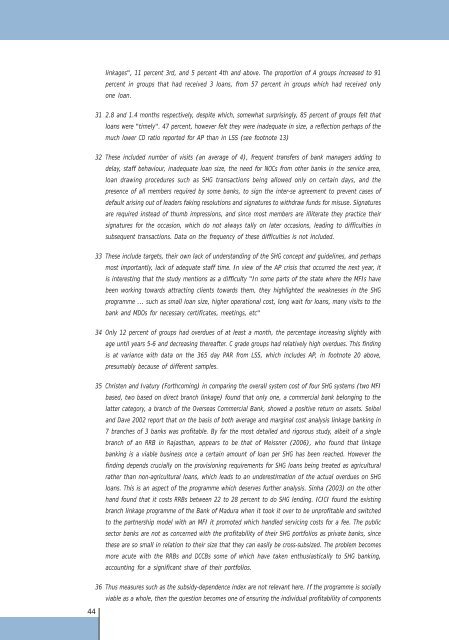Download sector_report1.pdf - Microfinance and Development ...
Download sector_report1.pdf - Microfinance and Development ...
Download sector_report1.pdf - Microfinance and Development ...
You also want an ePaper? Increase the reach of your titles
YUMPU automatically turns print PDFs into web optimized ePapers that Google loves.
linkages", 11 percent 3rd, <strong>and</strong> 5 percent 4th <strong>and</strong> above. The proportion of A groups increased to 91<br />
percent in groups that had received 3 loans, from 57 percent in groups which had received only<br />
one loan.<br />
31 2.8 <strong>and</strong> 1.4 months respectively, despite which, somewhat surprisingly, 85 percent of groups felt that<br />
loans were "timely". 47 percent, however felt they were inadequate in size, a reflection perhaps of the<br />
much lower CD ratio reported for AP than in LSS (see footnote 13)<br />
32 These included number of visits (an average of 4), frequent transfers of bank managers adding to<br />
delay, staff behaviour, inadequate loan size, the need for NOCs from other banks in the service area,<br />
loan drawing procedures such as SHG transactions being allowed only on certain days, <strong>and</strong> the<br />
presence of all members required by some banks, to sign the inter-se agreement to prevent cases of<br />
default arising out of leaders faking resolutions <strong>and</strong> signatures to withdraw funds for misuse. Signatures<br />
are required instead of thumb impressions, <strong>and</strong> since most members are illiterate they practice their<br />
signatures for the occasion, which do not always tally on later occasions, leading to difficulties in<br />
subsequent transactions. Data on the frequency of these difficulties is not included.<br />
33 These include targets, their own lack of underst<strong>and</strong>ing of the SHG concept <strong>and</strong> guidelines, <strong>and</strong> perhaps<br />
most importantly, lack of adequate staff time. In view of the AP crisis that occurred the next year, it<br />
is interesting that the study mentions as a difficulty "In some parts of the state where the MFIs have<br />
been working towards attracting clients towards them, they highlighted the weaknesses in the SHG<br />
programme … such as small loan size, higher operational cost, long wait for loans, many visits to the<br />
bank <strong>and</strong> MDOs for necessary certificates, meetings, etc"<br />
34 Only 12 percent of groups had overdues of at least a month, the percentage increasing slightly with<br />
age until years 5-6 <strong>and</strong> decreasing thereafter. C grade groups had relatively high overdues. This finding<br />
is at variance with data on the 365 day PAR from LSS, which includes AP, in footnote 20 above,<br />
presumably because of different samples.<br />
35 Christen <strong>and</strong> Ivatury (Forthcoming) in comparing the overall system cost of four SHG systems (two MFI<br />
based, two based on direct branch linkage) found that only one, a commercial bank belonging to the<br />
latter category, a branch of the Overseas Commercial Bank, showed a positive return on assets. Seibel<br />
<strong>and</strong> Dave 2002 report that on the basis of both average <strong>and</strong> marginal cost analysis linkage banking in<br />
7 branches of 3 banks was profitable. By far the most detailed <strong>and</strong> rigorous study, albeit of a single<br />
branch of an RRB in Rajasthan, appears to be that of Meissner (2006), who found that linkage<br />
banking is a viable business once a certain amount of loan per SHG has been reached. However the<br />
finding depends crucially on the provisioning requirements for SHG loans being treated as agricultural<br />
rather than non-agricultural loans, which leads to an underestimation of the actual overdues on SHG<br />
loans. This is an aspect of the programme which deserves further analysis. Sinha (2003) on the other<br />
h<strong>and</strong> found that it costs RRBs between 22 to 28 percent to do SHG lending. ICICI found the existing<br />
branch linkage programme of the Bank of Madura when it took it over to be unprofitable <strong>and</strong> switched<br />
to the partnership model with an MFI it promoted which h<strong>and</strong>led servicing costs for a fee. The public<br />
<strong>sector</strong> banks are not as concerned with the profitability of their SHG portfolios as private banks, since<br />
these are so small in relation to their size that they can easily be cross-subsized. The problem becomes<br />
more acute with the RRBs <strong>and</strong> DCCBs some of which have taken enthusiastically to SHG banking,<br />
accounting for a significant share of their portfolios.<br />
44<br />
36 Thus measures such as the subsidy-dependence index are not relevant here. If the programme is socially<br />
viable as a whole, then the question becomes one of ensuring the individual profitability of components














